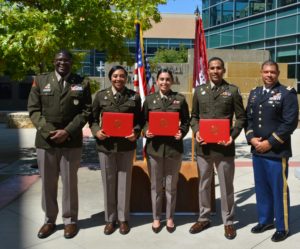FORT HOOD (Now designated Fort Cavazos), Texas – First Lieutenants Aunjaneice Thomas and Kassandra Beltz, Texas Army National Guard, and Krishna Shrestha are the Army’s latest physician assistants to graduate from the Carl R. Darnall Army Medical Center Interservice Physician Assistant Program during a ceremony held here, Sept. 30.
Over the past year, the graduates learned from several CRDAMC health care providers while simultaneously providing top-notch care to service members in support of the hospital’s mission of medical readiness. The graduates began their journey a year prior to coming to CRDAMC for clinical training following didactic training at Joint Base San Antonio – Fort Sam Houston.
“I know that this journey was not easy. It was challenging. It was tough — many nights, early days and a lot of studying, but it has to be that way because your duty as an Army physician assistant in the very near future will be a commander’s responsibility,” said Lt. Col. Ismael Flecha Jr., IPAP clinical coordinator, CRDAMC. “As you step out of training and embark on your new military career, I challenge you to keep in mind that this is just the beginning of what will be one of the most, sometimes challenging, progressions in the Army.”
Each year, the Army trains about 150 Soldiers through IPAP, where Soldiers complete a 16-month didactic phase and a 13-month clinical phase, and earn a master’s degree from the University of Nebraska in physician assistant studies.
“It’s been a tough journey, but I believe that anything that’s worth having is worth fighting for,” said Thomas when asked how challenging the course was.
Here at CRDAMC, we have such great staff that helped lighten the load in this journey, she added.
Physician assistants serve as the primary medical provider for Soldiers in battalion- and division-level units, and are responsible for unit medical readiness and training medics. They can also provide garrison health care to Soldiers, family members and other eligible beneficiaries.
“Just to brag on these students a little bit, they were the first class to be accepted right in the middle of the COVID pandemic, and we had to start class in a very uncertain environment,” said Maj. Torrance Nevels, senior physician assistant, 1st Medical Brigade.
Prior to the onset of the pandemic, and currently, lectures are in person, take up a long portion of the day, and graduates can easily move from lectures to labs and testing on base.
That was not the case for these graduates.
“I can’t image sitting through hours and hours of online lectures on the computer, driving back on base to do labs and taking tests, going back home to start the whole process over again every day and doing that for a whole year,” said Nevels. “These are some of the challenges these students had to work through, and they did outstanding.”
Being a medical service officer already, and after being introduced to the profession, becoming a physician assistant became a goal for Beltz.
“I’ve always wanted to be there helping people, and now it’s more so on the clinic aspect,” said Beltz.
The course was challenging, especially the first couple of months and over the first year—a lot of studying, no personal life and hitting the books, she added.
The U.S. Army, Navy and Air Force began separate physician assistant programs in the early 1970s. In 1996, the military services combined their various physician assistant programs to form IPAP at the U.S. Army Medical Department Center and School at Fort Sam Houston, Texas, now Joint Base San Antonio – Fort Sam Houston.
Initially interested in becoming a pilot, Shrestha ending up applying for the physician assistant program after a delay in the processing of his flight school application.
Shrestha has no regrets, adding that he is happy he chose the physician assistant medical specialty where he can help people. “Goals are possible through hard work,” he said.
-30 –










